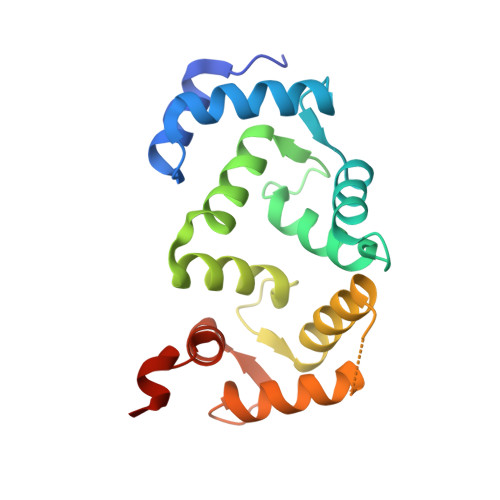The Guanine-Exchange Factor Ric8A Binds the Calcium Sensor Ncs-1 to Regulate Synapse Number and Probability of Release.
Romero-Pozuelo, J., Dason, J.S., Mansilla, A., Banos-Mateos, S., Sardina, J.L., Chaves-Sanjuan, A., Jurado-Gomez, J., Santana, E., Atwood, H.L., Hernandez-Hernandez, A., Sanchez-Barrena, M., Ferrus, A.(2014) J Cell Sci 127: 4246
- PubMed: 25074811
- DOI: https://doi.org/10.1242/jcs.152603
- Primary Citation of Related Structures:
4BY4, 4BY5 - PubMed Abstract:
The conserved Ca(2+)-binding protein Frequenin (homolog of the mammalian NCS-1, neural calcium sensor) is involved in pathologies that result from abnormal synapse number and probability of neurotransmitter release per synapse. Both synaptic features are likely to be co-regulated but the intervening mechanisms remain poorly understood. We show here that Drosophila Ric8a (a homolog of mammalian synembryn, which is also known as Ric8a), a receptor-independent activator of G protein complexes, binds to Frq2 but not to the virtually identical homolog Frq1. Based on crystallographic data on Frq2 and site-directed mutagenesis on Frq1, the differential amino acids R94 and T138 account for this specificity. Human NCS-1 and Ric8a reproduce the binding and maintain the structural requirements at these key positions. Drosophila Ric8a and Gαs regulate synapse number and neurotransmitter release, and both are functionally linked to Frq2. Frq2 negatively regulates Ric8a to control synapse number. However, the regulation of neurotransmitter release by Ric8a is independent of Frq2 binding. Thus, the antagonistic regulation of these two synaptic properties shares a common pathway, Frq2-Ric8a-Gαs, which diverges downstream. These mechanisms expose the Frq2-Ric8a interacting surface as a potential pharmacological target for NCS-1-related diseases and provide key data towards the corresponding drug design.
- Department of Molecular, Cellular and Developmental Neurobiology, Institute Cajal, CSIC, Avenida Dr. Arce 37, Madrid 28002, Spain.
Organizational Affiliation:


















